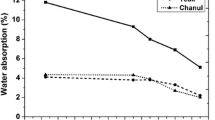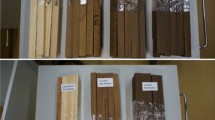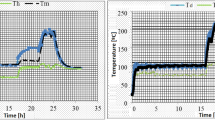Abstract
This study is aimed at evaluating the effect of thermal treatment on the physical and chemical properties of juvenile and mature wood from Pinus elliottii. Boards were taken from 35-year-old P. elliottii var. elliottii trees. The boards were thermally modified at 200 °C in the Laboratory of Wood Drying and Preservation from UNESP, Botucatu, SP, in Brazil. The results indicated that the thermal modification caused: (1) decreases of 20.1 % and 16.1 % in the equilibrium moisture content and volumetric swelling of mature wood, respectively; (2) decreases of 22.9 % and 14.8 % in the respective properties of juvenile wood; (3) increases of 34.1 % and 89.2 % in the extractive content of juvenile and mature wood, respectively; and (4) decreases of 3.4 % and 4.6 % in the respective holocelluloses content due to degradation in the hemicelluloses. It was found that juvenile wood presents an adverse effect on the chemical modification caused by thermal treatments. The influence of thermal modification in juvenile wood was lower than in mature wood and caused a greater uniformity in the physico-chemical variations between these types of wood.
Zusammenfassung
Ziel dieser Studie war es, den Einfluss einer thermischen Behandlung auf die physikalischen und chemischen Eigenschaften von juvenilem und adultem Kiefernholz (Pinus elliottii) zu untersuchen. Aus 35 Jahre alten Pinus elliottii var. elliottii Bäumen wurden Bretter eingeschnitten und im Labor für Trocknung und Imprägnierung der UNESP in Botucatu in Brasilien bei einer Temperatur von 200 °C thermisch modifiziert. Die thermische Modifikation führte zu folgenden Ergebnissen: (1) Rückgang der Gleichgewichtsfeuchte von adultem Holz um 20,1 % und der Volumenquellung um 16,1 %, (2) Rückgang der entsprechenden Eigenschaften von juvenilem Holz um 22,9 % bzw. 14,8 %, (3) Zunahme des Extraktstoffgehalts in juvenilem Holz um 34,1 % und in adultem Holz um 89,2 % und (4) Abnahme des Holocellulosegehalts in juvenilem Holz um 3,4 % und in adultem Holz um 4,6 % aufgrund des Hemicellulosenabbaus. Es zeigte sich, dass juveniles Holz durch thermische Behandlung anders chemisch modifiziert wurde als adultes Holz. Insgesamt war der Einfluss in juvenilem Holz geringer als in adultem Holz und die Unterschiede zwischen den physikalisch-chemischen Eigenschaften dieser beiden Holztypen wurden dadurch angeglichen.
Similar content being viewed by others
References
ABNT NBR 7190 (1997) Design of wooden structures. Associação Brasileira de Normas Técnicas, ABNT, Rio de Janeiro (In Portuguese)
Arnold M (2010) Effect of moisture on the bending properties of thermally modified beech and spruce. J Mater Sci 45:669–680
Bächle H, Zimmer B, Windeisen E, Wegener G (2010) Evaluation of thermally modified beech and spruce wood and their properties by FT-NIR spectroscopy. Wood Sci Technol 44:421–433
Bao FC, Jiang ZH, Jiang XM, Lu XX, Luo XQ, Zhang SY (2001) Differences in wood properties between juvenile wood and mature wood in 10 species grown in china. Wood Sci Technol 35:363–375
Bhuiyan TR, Hirai N, Sobue N (2000) Changes of crystallinity in wood cellulose by heat treatment under dried and moist conditions. J Wood Sci 46:431–436
Bhuiyan TR, Hirai N, Sobue N (2001) Effect of intermittent heat treatment on crystallinity in wood cellulose. J Wood Sci 47:336–341
Brito JO, Silva FG, Leão MM, Almeida G (2008) Chemical composition changes in eucalyptus and pinus woods submitted to heat treatment. Bioresour Technol 99:8545–8548
Calonego FW, Severo ETD, Assi PP (2005) Fiber length measurement for the determination of juvenile wood in Eucalyptus citriodora. Sci For 68:113–121 (In Portuguese)
Calonego FW, Severo ETD, Furtado EL (2010) Decay resistance of thermally-modified eucalyptus grandis wood at 140 °C, 160 °C, 180 °C, 200 °C and 220 °C. Bioresour Technol 101:9391–9394
Calonego FW, Severo ETD, Ballarin AW (2011) Physical and mechanical properties of thermally-modified wood from eucalyptus grandis. Eur J Wood Prod. doi:10.1007/s00107-011-0568-5
Esteves B, Marques AV, Domingos I, Pereira H (2007) Influence of steam heating on the properties of pine (Pinus pinaster) and eucalypt (Eucalyptus globulus) wood. Wood Sci Technol 41:193–207
Ferreira AL, Severo ETD, Calonego FW (2011) Determination of fiber length and juvenile and mature wood zones from Hevea brasiliensis trees grown in Brazil. Eur J Wood Prod 69:659–662
Foelkel CEB, Ferreira M, Nehring JH, Rolim MB (1975) Variability in the radial direction of Pinus elliottii wood. Inst Pesqui Cienc Florestais 10:1–11 (In Portuguese)
Forest Products Laboratory (1999) Wood handbook: wood as an engineering material. USDA, Washington
Goldschmid O (1971) Ultraviolet spectra. In: Sarkanen KV, Ludwig CH (eds) Lignins. Wiley-Interscience, New York, pp 241–266
Kamdem DP, Pizzi A, Jermannaud A (2002) Durability of heat-treated wood. Holz Roh- Werkst 60:1–6
Larson PR, Kretschmann DE, Clark AIII, Isebrands JG (2001) Formation and properties of juvenile wood in southern pines: a synopsis. USDA / Forest Service / Forest Products Laboratory, Madison
Metsä-Kortelainen S, Anitikainen T, Viitaniemi P (2006) The water absorption of sapwood and heartwood of scots pine and Norway spruce heat-treated at 170 °C, 190 °C, 210 °C and 230 °C. Holz Roh- Werkst 64:192–197
Millitz H, Tjeerdsma B (2001) Heat treatment of wood by the PLATO-process. In: RAPP AO. Review on heat treatments of wood. Proceedings of the special seminar: environmental optimisation of wood protection. Cost Action E 22, Antibes, France, pp 27–38
Palermo GPM, Latorraca JVF, Severo ETD, Rezende MA, Nascimento AM (2011) Juvenile and mature wood transition of Pinus elliottii from anatomical and physical properties. In: Proceedings of the Congreso Ibero-Latinoamericano de la madera en la construcción, CIMAD 11, Coimbra, Portugal, 9p (In Portuguese)
Papadopoulos AN (2006) Pyridine-catalyst acetylation of pine wood: influence of mature sapwood vs juvenile wood. Holz Roh- Werkst 64:134–136
Severo ETD, Calonego FW (2009) Thermal modification process for heat radiation to improve the dimensional stability and biological durability of solid wood. INPI, PI0902/38-8A2 (In Portuguese)
Technical Association of the Pulp and Paper Industry—TAPPI 12 Wd-82 (1999) Preparation of wood for chemical analysis. TAPPI, Atlanta
Technical Association of the Pulp and Paper Industry—TAPPI 222 Om-98 (1999) Acid-insoluble lignin in wood and pulp. TAPPI, Atlanta
Vernois M (2001) Heat treatment of wood in France: state of the art. In: RAPP AO. Review on heat treatments of wood. Proceedings of the special seminar: environmental optimisation of wood protection. Cost Action E 22, Antibes, France, pp 39–46
Waskett P, Selmes RE (2001) Opportunities for UK grown timber: wood modification state of the art review. Building Research Establishment LTD, proj 203-343
Wikberg H, Maunu SL (2004) Characterization of thermally-modified hard- and softwoods by 13C CPMAS NMR. Carbohydr Polym 58:461–466
Zobel BJ, Van Buijtenen JP (1989) Wood variation: its causes and control. Springer, New York
Acknowledgements
The authors thank the Research Assistance Foundation from São Paulo (FAPESP) and the Coordinator for the Improvement of Higher Level Personnel (CAPES), Brazil, for financial support through grant numbers 07/57065-6 and PNPD-02405/09-1.
Author information
Authors and Affiliations
Corresponding author
Rights and permissions
About this article
Cite this article
Severo, E.T.D., Calonego, F.W. & Sansígolo, C.A. Physical and chemical changes in juvenile and mature woods of Pinus elliottii var. elliottii by thermal modification. Eur. J. Wood Prod. 70, 741–747 (2012). https://doi.org/10.1007/s00107-012-0611-1
Received:
Published:
Issue Date:
DOI: https://doi.org/10.1007/s00107-012-0611-1




